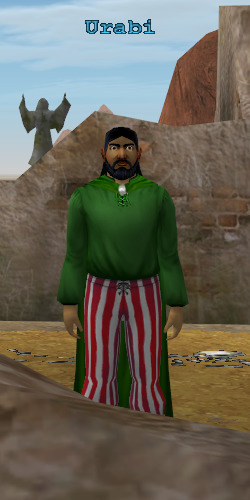NPC: Urabi
Location: Tahraji Desert
Coordinates: 292, 323
An archaeologist who is studying the ruins in Tahraji Desert to learn more about its history.

Speak the Words
Text may not be 100% complete. Most quest text is not included.
Due to multiple options when speaking, text below may not be in comprehensive order.
*Peering over the shoulder of a dwarf, you see him sketching the ruins around him. On another sheet, he carefully adds minor details about this location to an overall sketch ofEL-DB.com Matajin Ruins. On still another sheet, he writes detailed descriptions about what he is seeing giving precise measurements and coordinates.* I'll be with you in just a moment.
Who are you?
I am Urabi. *He notices you admiring his sketches.* Are you interested in my sketches? They're part of a survey I'm doing.You're not an artist?
Artist? No. I'm an archaeologist, actually. I've begun studying these ruins around us here.Survey
Before I can begin to uncover features, artifacts, and other remains, a detailed survey has to take place. In a way, it is a map of what can be seen before the actual digging can begin. Precise measurements, coordinates, and topographical features must be identified since they may provide clues to what lies beneath.Archaeologist
A kind of scientist: I study what people have left behind such as these buildings. I do this so that I can understand what life must have been like for them. Their presence here is part of the local history and I'd like to understand those events better. This field has it's obstacles, however.How?
First things first. I start off by doing a survey of what's here that I can see. At a later point, I'll take samples of the mortar here to analyze. I'll compare that to modern mortar samples to see if there are any differences.What will that reveal?
Perhaps nothing at all, but it will be one more piece of information about who lived here and what kind of resources that were available to them.Like that anvil?
Things found above ground that are not part of the structures can be suspect since it isn't clear that the anvil, for example, was left here by those who once lived herEL-DB.come or left by someone more recently. The question remains why someone would leave something that valuable behind. Regardless, it will be catalogued with everything else.What can be clear?
Once excavating begins, I will start exposing the various geological layers beneath what we see here. Items found within those layers can be dated to that period of time. The deeper an item is found, the older it is.Does anyone STILL live here?
In this region of Draia? There are tribes that still live hidden within the sands of this desert. I've run into a woman named Lehha on multiple occasions. She points me in the right directions of pertinent ruins. She must be a survivor of the downfall of Matajin. I mean, how else would you know where to find all these buildings without digging?More
I've also run into a man named Oren who used to be a priest of some god I've never heard of. Maybe when I find the ruins of the temple, I can learn more about this so-called 'god.' That's what my research is all about: learning about cultures and events I haven't experienced myself. There is also an orchan woman equipped with a pen and paper.
More
At first, I thought she was an archaeologist as well, but then I learned she is a writer for the Association of Scribes and Scholars. I suggested that if I make a significant find, she should write about it. She said no: her reason being she only writes about combat and action-packed events. Sounds like a load of bull if you ask me.
Is that important?
Very important. It's as important as telling a story. A story always has a beginning, a middle, and an end. Can you imagine hearing a story where the end is related first, then the middle, and finally the beginning?What's fun about that?
It describes what I, as an archaeologist, am trying to do. Look around you here. This is the end of the story. You have to ask yourself, how and when did this begin? what happened in the middle? what events happened to make this specific ending happen? Who lived here? what was life like for them? what did they value? what did they believe? where did they come from?More
I intend to find out by discovering and interpreting the clues around and beneatEL-DB.comh me in reverse order, only then can I tell their story in the proper sequence.